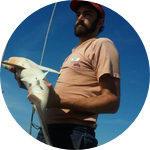About This Project
My fellow researchers and I have discovered a new digenean trematode parasite in bay scallop populations on the North Carolina coast. Initial surveys have revealed a high prevalence of infection in adult scallops. We need to acquire basic information on the parasite's distribution, life cycle, and potential affects on scallop behavior, survivorship, and reproduction in order to better inform managers, fishermen, and aquaculturists alike.Ask the Scientists
Join The DiscussionWhat is the context of this research?
We have identified a new digenean trematode parasite in bay scallops taken from across coastal North Carolina. Despite having never been documented before, this parasite has been found in a disturbingly large proportion of collected scallops. In other scallop species, trematodes are known to cause varying levels of tissue damage, resulting in reduced growth, fitness, and survivorship. This parasite proliferates in the gill tissues of infected scallops, potentially compromising gill function and impeding the uptake of oxygen and nutrients. If the prevalence of this parasitic infection is sufficiently high, negative effects conferred by infection could have major consequences for an already ailing fishery.
What is the significance of this project?
North Carolina's bay scallops have experienced years of low numbers due to a red tide event that decimated populations in 1987. A boom in predatory ray populations and declining seagrass habitat have been pinpointed as some of the reasons why scallop populations have yet to recover. Researchers and policy makers are focused on finding out why the scallops populations are suffering and developing ways to sustain populations for the future.
Pervasive parasitism in bay scallops could be yet another important factor preventing the recovery of this commercially and economically important species. The proposed research will help us better understand the impacts of this parasite on scallops, and may ultimately provide information that allows for better managment of scallop stocks.
What are the goals of the project?
Research Objectives
- Assess infection prevalence by this parasite in scallop populations throughout their range. Surveys will allow us to see the range of this parasite, identify infection hotspots, and link prevalence with site characteristics.
- Determine parasite life cycle. Knowing the life cycle is key to understanding spatial and seasonal patterns of infection.
- Determine the effects of infection on host growth, behavior, and mortality. Lab observations suggest that infection may increase mortality by compromising gill function. We want to quantify parasite effects on host fitness with a series of lab and field experiments.
Research Products
- A scientific publication detailing the results of our inquiries
- Valuable information for managers
- Classroom materials and videos for use in local schools
Budget
Surveying parasite prevalence in bay scallop populations over a wide spatial scale requires a lot of travel over land and water. Thus, the biggest chunk of our budgetary requirements lies in transportation costs: boat usage fees, fuel, and ferry fees.
A smaller chunck of change will be used to purchase tools and materials required to set up experiments to examine growth, fitness, and survirorship of infected bay scallops.
Meet the Team
Team Bio
Joe Morton is currently pursuing a PhD in Marine Sciences at UNC Chapel Hill and specializes in the ecology of marine parasites. Morton has a passion demonstrating the diverse and often powerful effects of parasites on ecosystem characteristics. He is currently investigating how Digenean Trematode parasites alter salt marsh community structure and function by modifying the behavior of their keystone gastropod host species, Littoraria irrorata. His discovery of a novel digenean trematode using the bay scallop in the fall of 2013 has prompted the proposed research.In his spare time, Morton is an active ceramist, swimmer, scientific illustrator, poet, and musical composer.
Additional Information
To express my deep gratitude for contributing to my project, I will provide gifts for different levels of contribution!$10 - Live updates, pictures, and videos from the field and lab
$50 - A post card featuring a beautiful electron microscope image of the parasite
$250 - Like art? Like science? Awesome! Donors at this level will recieve a hand-thrown ceramic mug with the UNC IMS logo. I'll even glaze them in your favorite color.
$500 and up - You will recieve everything plus the opportunity to go on a kayak ecotour with me as your guide. Afterwards you will be treated to a delicious clam chowder dinner at my house.*
*transportation and lodging not provided
_________________________________________________________________________________________
Project Backers
- 62Backers
- 101%Funded
- $5,070Total Donations
- $81.77Average Donation
